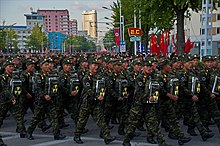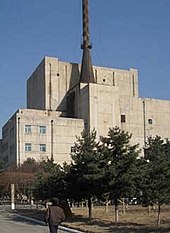North Korea and weapons of mass destruction
In April 2009, reports surfaced that North Korea has become a "fully fledged nuclear power", an opinion shared by International Atomic Energy Agency (IAEA) Director General Mohamed ElBaradei.The United States reaffirmed that it had no hostile intent toward the DPRK and was prepared to improve bilateral relationships, and agreed to ship humanitarian food aid to North Korea.[34][35][36] The United States called the move "important, if limited", but said it would proceed cautiously and that talks would resume only after North Korea made steps toward fulfilling its promise."What we're speculating is they tried to do a boosted nuclear device, which is an atomic bomb that has a little bit of hydrogen, an isotope in it called tritium," said Joseph Cirincione, president of the global security firm Ploughshares Fund.Despite North Korean claims that the rocket was for peaceful, scientific purposes, it has been heavily criticized as an attempt to perform an ICBM test under the guise of a satellite launch.In late 2002 and early 2003, North Korea began to take steps to eject International Atomic Energy Agency inspectors while re-routing spent fuel rods to be used for plutonium reprocessing for weapons purposes.[82][83] On February 12, monitors in Asia picked up unusual seismic activity at a North Korean facility at 11:57 (02:57 GMT), later determined to be an artificial quake with an initial magnitude 4.9 (later revised to 5.1).[90] On January 7, after reports of a magnitude 5.1 earthquake originating in northeast North Korea at 10:00:01 UTC+08:30, the country's regime released statements that it had successfully tested a hydrogen bomb.[98] On February 18, 2017, China announced that it was suspending all imports of coal from North Korea as part of its effort to enact United Nations Security Council sanctions aimed at stopping the country's nuclear weapons and ballistic-missile program.[100] The move prompted US Secretary of State Rex Tillerson to embark on a diplomatic mission ten days later to Japan, South Korea and China, in an effort to address the heightened international tension in the region.The parade took place amid hot speculation in the United States, Japan, and South Korea that the country would also potentially test a sixth nuclear device,[103] but failed to do so.[108][109][110] On April 16, 2017, hours after the military parade in Pyongyang, North Korea attempted to launch a ballistic missile from a site near the port of Sinpo, on the country's east coast.[111][112] Later that month, after a visit to Washington by the top Chinese leader, the US State Department announced that North Korea was likely to face economic sanctions from China if it conducted any further tests.[114] On July 4, 2017, North Korea launched Hwasong-14 from Banghyon airfield, near Kusong, in a lofted trajectory it claims lasted 39 minutes for 930 km (578 mi), landing in the waters of the Japanese exclusive economic zone.[115][116][117] By targeting the deep waters in the Sea of Japan, North Korea was ensuring that American or Japanese divers would encounter difficulties when attempting to recover Hwasong-14's engine.[122][123][124] On August 8, 2017 The Washington Post reported that the Defense Intelligence Agency, in a confidential assessment, stated that North Korea has sufficiently miniaturized a nuclear warhead to fit inside one of its long-range missiles.[136] In August 2019, Japan has upgraded its estimate of North Korea's nuclear weapons capability in an upcoming annual Defence White Paper, saying it seems Pyongyang has achieved the miniaturization of warheads.[142] On March 24, 2023, North Korea unveiled the Hwasan-31 [ko] tactical nuclear bomb with at least 10 warheads shown with an estimated diameter from 40 to 50 centimeters as reported by the South Korean media.In December 2002, claiming North Korean non-compliance, the United States persuaded the KEDO Board to suspend fuel oil shipments, which led to the end of the Agreed Framework.[186] In 2009 the International Crisis Group reported that the consensus expert view was that North Korea had a stockpile of about 2,500 to 5,000 metric tons of chemical weapons, including mustard gas, sarin (GB) and other nerve agents.[186] In October 2013, South Korea and the United States "agreed to build a joint surveillance system to detect biochemical agents along the demilitarized zone" and to share information.[186] Also in 2015, Melissa Hanham of the James Martin Center for Nonproliferation Studies released an analysis of a photograph of North Korean supreme leader Kim Jong Un visiting the Pyongyang Bio-technical Institute, a factory supposedly for the production of bacillus thuringiensis of use in pesticides.South Korea responded with sanctions and a joint drone drill with the US, while the UN Security Council planned to address the missile activity amid regional tensions.[204] In January 2020, Vice Chairman of the Joint Chiefs of Staff John E. Hyten said "North Korea is building new missiles, new capabilities, new weapons as fast as anybody on the planet.[207] The Congressional Research Service issued a report citing a 2017 assessment by the Defense Intelligence Agency that North Korea has achieved a level of miniatuarization of nuclear warheads needed to mount them on short range and intercontinental ballistic missiles.[252] KOMID has also been responsible for the sale of equipment, including missile technologies, gunboats, and multiple rocket artilleries, worth a total of over $100 million, to Africa, South America, and the Middle East.[257][better source needed] A UN Security Council sanctions committee report stated that North Korea operates an international smuggling network for nuclear and ballistic missile technology, including to Myanmar (Burma), Syria, and Iran.This broke down when North Korea's clandestine uranium enrichment program came to light in 2002, after which China convened the six-party talks to negotiate a step-by-step process to denuclearization.In 2018, Presidents Moon Jae-in of South Korea and Donald Trump of the United States held a series of summits with Kim Jong Un which led to declarations in favor of the denuclearization of the Korean peninsula.[271] The visit by the intelligence officials was in tandem with the September 2018 Pyongyang Agreement, which saw North Korean leader Kim Jung-Un agree to close Sohae and allow international experts to observe the dismantling of the missile engine testing site and a launch pad.






Nuclear power in North KoreaOctober 9, 2006September 3, 2017Korea Meteorological AdministrationNORSARHwasong-17Weapons of mass destructionBiologicalChemicalNuclearRadiologicalBy countryAlbaniaAlgeriaArgentinaAustraliaBrazilBulgariaCanadaFranceGermanyIsraelKazakhstanMexicoMyanmarNetherlandsPakistanPhilippinesPolandRhodesiaRomaniaRussiaSoviet UnionSaudi ArabiaSouth AfricaSouth KoreaSwedenSwitzerlandTaiwanUkraineUnited KingdomUnited StatesYugoslaviaMissilesList of treatiestreaty partiesNuclear weaponsNuclear explosionHistoryWarfareDesignTestingDeliveryEffectsWorkersEthicsArsenalsTarget selectionArms raceBlackmailEspionageProliferationDisarmamentTerrorismUmbrellaOppositionWinterNuclear-armed statesMissile tests2021–2023Nuclear tests2016 (January)2016 (September)1994 North Korean nuclear crisis2017–2018 North Korea crisisKorean People's ArmyKorean People's Army Strategic Rocket ForceNyongbyon Nuclear Scientific Research CenterPunggye-ri Nuclear Test SiteRyanggang explosionSongunNorth Koreamilitarynuclear weapons programarsenalfissile materialbiological weaponsTreaty on the Non-Proliferation of Nuclear Weaponssix nuclear testssanctionsTimeline of the North Korean nuclear programYongbyon Nuclear Scientific Research Centerresearch reactorfuel rodUN Security CouncilAgreed FrameworkClinton's presidencyPakistan's nuclear technologyfirst nuclear testunderground nuclear explosionkilotonsix-party talksBanco Delta AsiaInternational Atomic Energy AgencyYongbyon nuclear reactorMohamed ElBaradeisecond nuclear testMantapsanKilju CountyearthquakeU.S. Geological Surveyseismicthird underground nuclear testFederal Institute for Geosciences and Natural ResourcesUnited States Geological Surveyfourth underground nuclear testhydrogen bombtritiumJoseph CirincionePloughshares Funda satelliteJapanese Prime MinisterShinzō AbeUnited Nationssanctions against North KoreaIn September 2017